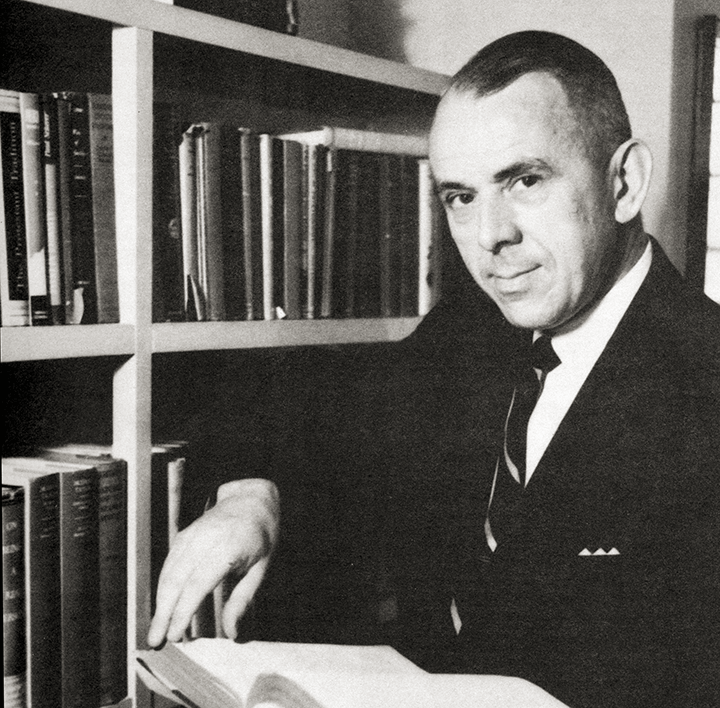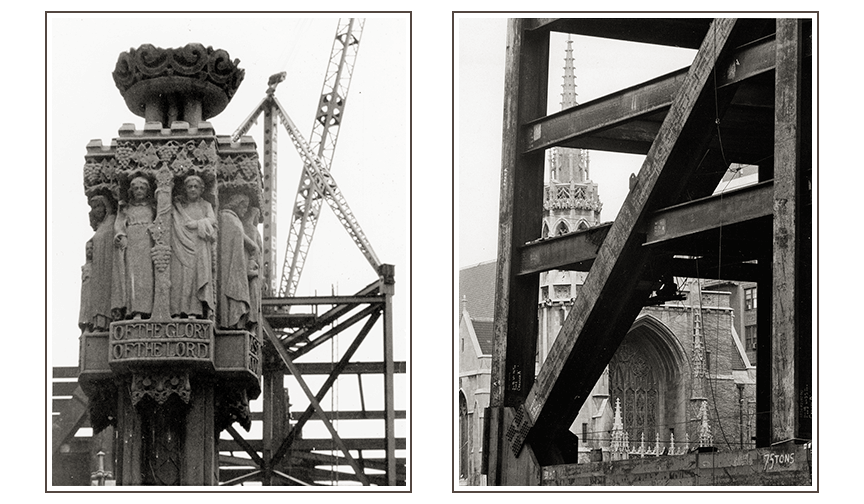“The church primarily exists for those outside of it.”
—Elam Davies
In the wake of Harrison Ray Anderson’s retirement announcement, a Pastor Nominating Committee was quickly convened, and within seven months they had already identified their primary candidate: Elam Davies, a well-known and dynamic Welsh preacher who was serving a church in Pennsylvania. Much like his predecessors, Davies initially resisted the call, reflecting later that he found Fourth Church to be “elitist and unwelcoming.” After the committee offered Davies the position a third time, however, one of his friends offered an observation that would define Davies’ ministry: “Maybe God is calling you to change their mindset.”

Elam Davies, born in Grovesend, Wales, and a graduate of Cambridge University, served as pastor of Fourth Church from 1961 to 1984. He was listed by Time magazine in 1979 as among the country’s “seven star preachers.”
Davies ended up accepting, beginning in September 1961 right after Anderson retired. The two men had notably different personalities—Anderson was often described as formidable and outgoing, while Davies was shy and introverted (outside the pulpit anyway)—but Davies would quickly prove himself quite adept at facilitating long-needed changes. An example of this—particularly in light of last month’s article—was in 1963 hiring onto the Fourth Church staff a recent McCormick Seminary graduate named Lesslie Anbari, who soon became just the third woman to be ordained as a minister in the Presbytery of Chicago.
In addition, one of Davies’ early battles was bringing an end to Fourth Church’s embarrassingly long-running practice of pew rentals, something John Timothy Stone had decried as “a thing of the past” all the way back in 1921. Over a period of two years, Davies leaned on prominent members to help convince Session to end the practice, ultimately leading to a suspension of new pew rentals in 1964 (though several families still rented pews well into the 1980s).
These changes were admittedly minor compared to the wider landscape of the 1960s; the civil rights movement, countercultural revolution, and high-profile political assassinations (Kennedys, Malcolm X, Martin Luther King Jr.) are just a few of the defining events and headlines from that time period. But while Fourth Church wasn’t yet ready to engage in those national conversations, it soon found its voice was needed locally as the neighborhood around Fourth Church—and one mile to its west—underwent rapid transformation.
Hard as it may be to believe, prior to 1960 most members still thought of Fourth Church as a neighborhood church. Over the course of the decade, though, mansions and two-story flats made way for luxury apartments and high-rises, slowly becoming the Gold Coast that we know today. The ongoing juxtaposition of the church and the Hancock building, completed in 1969, has come to symbolize this delicate position in which Fourth Church continually finds itself: serving as a contrast to, but also squarely a part of, one of the most affluent neighborhoods in the country.

Construction of the 100-story John Hancock Center directly across from Fourth Church began in 1965; the building opened for occupants in 1969. Radically changing the scale of the North Michigan Avenue neighborhood, the Hancock was at the time of its topping off the second-tallest building in the world (behind the Empire State Building in New York City).
One mile to the west, though, a different sort of transformation was underway. In 1957 the Chicago Housing Authority announced a massive expansion to the Cabrini Rowhouses built in 1942, soon followed by a second expansion in 1962 when it became known as Cabrini-Green. The history of Cabrini-Green is far too complex to contain in a sentence or two, but the shorthand version is that while these public high-rises were initially described by city officials as an “urban renewal” program, they were a deeply flawed and fraught concept which—combined with years of mismanagement and discriminatory policies—eventually led Cabrini-Green to be regarded as one of the worst public housing situations in the country.

The Cabrini-Green public housing project, constructed in stages during the 1940s, 50s, and 60s, was demolished between 1995 and 2011. Today only the original two-story rowhouses remain, just north of the Chicago Lights Urban Farm on West Chicago Avenue.
Davies had become involved with several urban ministry committees when he began—including the ecumenical Committee on Community Organizing—and by the middle of the decade there was a growing awareness of the responsibility that congregations like Fourth Church held to their neighbors. Davies had long preached that “the church primarily exists for those outside of it,” and Fourth Church ended up embracing that motto through a jaw-dropping expansion of programming in the late sixties. Within a span of five years, programs were created to serve Hispanic youth (The Pres, 1965), youth from Cabrini-Green (Tutoring Program + Culture Center, 1965), seniors and older adults (1965, now known as the Center for Life and Learning), as well as to offer a summer day camp (1966), an area preschool (Day School, 1968), and tutoring to those in prison (1970). That many of these programs still exist more than fifty years later is a testament to the remarkable vision Davies had and the clear need these programs continue to meet.
These programs “did not destroy the social boundaries of privilege, class, and race,” James Wellman writes in The Gold Coast Church and the Ghetto, but they “did make those lines of demarcation less rigid and more permeable.” And with Davies’ desired change in mindset came a pronounced change in demographics as well. In 1961, the average age of a Fourth Church member was around fifty-seven years old, but by the end of the decade, more than half of the church’s members were under the age of forty.
Much like John Timothy Stone’s drive to evangelize a rapidly shifting neighborhood had fundamentally changed Fourth Church, Davies’ emphasis on serving “the last, the lost, the least, and the lonely” helped the church discover a new calling and identity as it prepared to enter its second century as a congregation in 1971—a topic or the next chapter.
• • •
< Back to Part 7 • On to Part 9 >